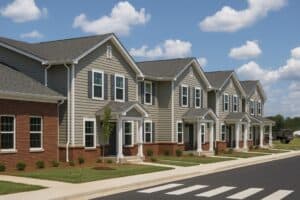Key Takeaways:
- Military housing faces unique challenges requiring innovative solutions.
- Recent initiatives focus on improving indoor environmental quality and resident satisfaction.
- Collaborations between private companies and the military are driving significant improvements.
Table of Contents:
- Introduction
- The Need for Innovation in Military Housing
- Enhancing Indoor Environmental Quality
- Leveraging Technology for Maintenance Training
- Resort-Style Living for Unaccompanied Service Members
- Significant Investments in Housing Improvements
- Conclusion
Introduction
High-quality military housing is not only essential for supporting the day-to-day lives of service members and their families, but also plays a critical role in their morale, health, and readiness. However, military installations have long grappled with the limitations imposed by outdated infrastructure and evolving family needs, highlighting the importance of rethinking traditional approaches. Addressing these challenges requires strong leadership and vision—qualities embodied by individuals such as John Picerne, whose efforts in the military housing sector have helped drive collaborative improvements between public and private stakeholders.

Recognizing that thriving military communities depend on healthy, resilient, and high-quality residences, the Department of Defense and private housing partners are instituting fresh initiatives. These efforts aim to provide a new standard of living—one that centers comfort, sustainability, and the well-being of residents as part of the military’s commitment to supporting service members holistically.
The Need for Innovation in Military Housing
Historically, military housing has struggled to keep pace with the evolving demands of its occupants. Persistent challenges include aging facilities, inconsistent maintenance, and insufficient amenities—all of which can contribute to diminished morale and even hamper operational readiness among troops. Responses to these issues have gained urgency in recent years, as both active duty and family members raise concerns about the adequacy and safety of their homes.
In response, the U.S. military has ramped up initiatives to innovate beyond patchwork improvements. Instead, they are pursuing systemic overhauls through deep partnerships with leading developers and service providers, many of whom bring expertise from the civilian housing sector. This collaborative model aims to establish modern standards for military housing that reflect resident feedback and adhere to evidence-based best practices.
Examining best practices and drawing on proven solutions from wider markets, these efforts aim not just to repair existing problems but to create a foundation for long-term satisfaction and functionality in military communities. By involving both families and housing professionals in the process, it is hoped that expectations will be reshaped and housing will be better aligned with the diverse needs of the force.
Enhancing Indoor Environmental Quality
One of the most promising advancements in military housing involves prioritizing indoor environmental quality (IEQ)—a focus that encompasses improvements in air, water, and lighting. These upgrades are critical, especially given the close ties between health, comfort, and environmental factors. A strong example comes from recent projects at Fort Meade, Maryland, where a dedicated IEQ program led to an 82% increase in overall satisfaction with on-post housing and a dramatic 93% increase in water quality ratings.
These improvements are made possible through the integration of advanced filtration, ventilation, and moisture control technologies, as well as upgrades to lighting systems designed around circadian health. Such changes not only foster healthier homes, but also contribute to energy efficiency and lower utility costs—benefits that both residents and military administrators increasingly value. Coverage of these initiatives in large publications, such as the Military Housing Association, highlights their broad significance to military families and underscores the impact of evidence-driven investments in quality of life.
Leveraging Technology for Maintenance Training
The effective upkeep of military homes is a foundational element of resident satisfaction. To streamline and upgrade maintenance capabilities, technology is being harnessed to provide modern, flexible training solutions for service technicians. Interactive, mobile-accessible platforms developed by companies like Interplay Learning allow maintenance teams to practice diagnosing and repairing various housing issues virtually. This hands-on, scenario-based training ensures teams remain up-to-date with the latest building technologies and safety protocols.
These learning solutions enable a faster and more responsive approach to maintenance challenges. Teams can practice new techniques in a risk-free environment, thereby reducing errors and downtime. For service members and families, this leads to speedier repairs and a more professional approach to maintenance, helping foster trust in the housing system. The integration of such tools represents a culture shift in military property management—one that embraces adaptability and continuous learning as core values.
According to a resource report by Military.com, effective maintenance training remains a critical focus area, with ongoing evaluation and adaptation needed to meet future housing standards.
Resort-Style Living for Unaccompanied Service Members
In an effort to enhance the living experience for unaccompanied and junior-ranking service members, innovative projects are being developed that draw inspiration from both resort and student housing models. Developments such as the Fort Irwin Apartments offer contemporary amenities, social spaces, and modernized designs—creating a higher quality of life for those living away from their families or stationed at remote posts. These facilities provide much-needed comfort, community engagement opportunities, and a supportive environment, which are crucial given the unique challenges faced by unaccompanied members.
This approach supports retention and morale, providing a residential experience comparable to that enjoyed by civilians in their early careers. The blending of traditional military housing with best practices from private sector developments is part of a wide-ranging effort to ensure all service members feel valued and at home, regardless of their assignment or rank.
Significant Investments in Housing Improvements
The progress seen across military housing sectors reflects an unprecedented level of financial commitment. More than $1 billion has been allocated for the construction of new homes and the renovation of existing housing at bases such as Fort Campbell, Fort Cavazos, and Fort Knox. These funds are catalyzing changes in building materials, layout design, security features, and community programming—all with a focus on resident-centric advancement.
New forms of accountability also accompany these major investments. Enhanced resident feedback mechanisms, third-party inspections, and benchmarking against civilian housing standards help to ensure these resources generate real and sustained benefits. As reported by The Washington Post, these improvements are now at the forefront of military housing policy, representing a firm commitment to continuous quality enhancement for those who serve.
Conclusion
The movement to transform military housing combines innovation, collaboration, and robust investment. By targeting environmental quality, building maintenance capacity, and creative residential solutions for both families and unaccompanied service members, the military is setting new standards for support and well-being. These efforts demonstrate how the integration of advanced technology, industry expertise, and sustained funding can deliver tangible, life-improving results for America’s service members and their families—now and into the future.


